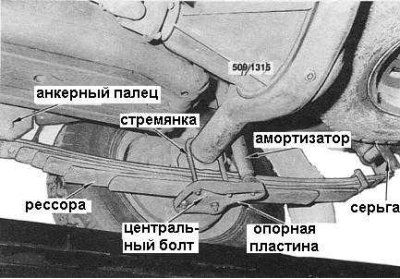The final drive ratio of all models except Patrol ST and Ti with manual transmission, models with 3.0L engine and Maverick XLT is 4.111:1. The gear ratio of the 3.0L models is 4.375:1, while the ST, XL and Ti models are 3.900:1.
The final drive gear assembly with differential is mounted in two tapered roller bearings, and the radial play and preload are adjusted by means of special nuts.
The drive gear is also installed in two tapered roller bearings, the preload of which is determined by the selection of an adjusting washer of the required thickness installed between them. The driving gear seating depth is corrected by selecting an adjusting washer installed between the gear and the inner bearing cone.
Limited slip differential (LSD) continuously transmits rotation to both rear wheels, however, the torque is redistributed to the wheel with minimal slip. When one of the side gears begins to rotate faster than the opposite, the pinion axle rotates slightly, pushing the planetary assembly casings apart, which leads to an increase in the load on the friction plates and discs.
Locking differential permanently (being blocked) transmits rotation to both rear wheels evenly, regardless of the degree of their slippage and is controlled by a switch that directs the vacuum through two electromagnetic valves to the executive chamber, fixed in the rear of the axle housing.
When the differential lock is engaged, vacuum is applied to one side of the chamber. In this case, the shift fork and the selector clutch are displaced towards the differential assembly. The selector clutch slides along the splines to the differential housing and, engaging with the rear of the side gear, stops the rotation of the latter, thereby locking the differential. When the lock is released, vacuum is applied to the opposite half of the chamber, returning the fork with the clutch to its original position.
The differential lock should only be engaged when the rear wheels are stationary and the vehicle speed at the time of engagement does not exceed 7 km/h.
The procedures for removing and installing assemblies of all main gears are identical, however, in the event of a failure of the locking differential, the compilers of this Guide recommend driving the car away for repairs to the workshop of the car manufacturer's dealership.
Axle shafts on models with rear wheel drum brakes are equipped with one tapered roller bearing (each), on models with disc brakes - two tapered roller bearings. Bearing (And) each axle shaft is enclosed in a casing fixed at the end of the sleeve of the crankcase of the bridge. The casing is attached to the axle shaft by means of a lock washer and nut. The axle shaft seals are located at the outer ends of the axle housing.
The rear suspension can be made both on leaf springs and on coil springs.
In the first case, the suspension includes a leading rear axle suspended on semi-elliptical leaf springs (springs). The springs are mounted on rubber bushings. The front end of the spring is attached to the chassis frame by means of an anchor pin, the rear end - by a mounting earring.
Shock absorbers are mounted on rubber bushings. Their lower ends are fixed on the support plates of the spring ladders, the upper ones are attached to the chassis frame.

The rear axle is exposed on the springs by means of the central bolts of the latter, and is attached to them with U-shaped bolts of stepladders with nuts. The rear suspension components are shown in the accompanying illustration.

On vehicles with spring-type suspension, the leading rear axle is hung out by means of four longitudinal torque rods and a transverse torque rod (see accompanying illustration).
The long travel of the coil springs is controlled by double-acting hydraulic shock absorbers. The transverse stability stabilizer is installed between the axle housing and the vehicle chassis to limit the swaying of the vehicle body during operation. On some models, a remote cable drive is provided to disable the operation of the anti-roll bar to facilitate the movement of the vehicle in off-road conditions. The disconnect mechanism provides free play of the right end of the stabilizer bar.
The chassis of the car is equipped with a rubber compression stroke limiter, which serves to prevent direct contact between metal parts when the coil springs are fully compressed.
The use of maintenance-free rubber bushings at the axle points of the suspension components can significantly reduce the noise level emitted by the suspension. Check the condition of the bushings from time to time.